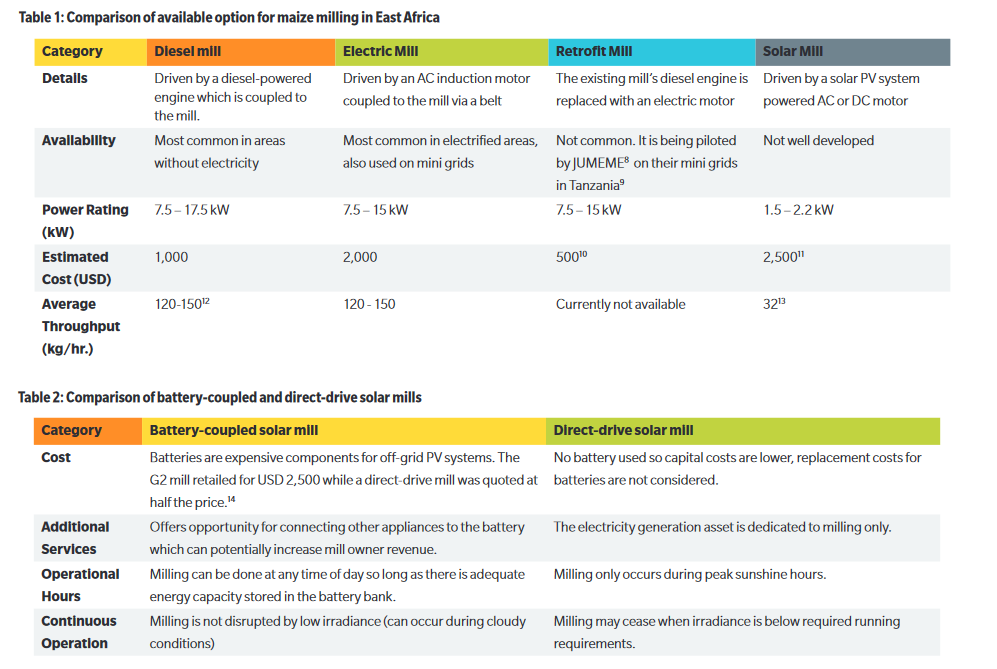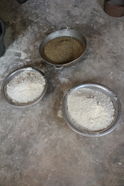Grain Mill
Overview
To prepare the cereals for further processing, the chaff has to be separated from grain, either manually with a winnowing tray or mechanically by a powered shaker or grinder. Mechanical power is also available for dehusking rice or shelling maize as an alternative to manual work with rice hullers or huskers and maize shellers. The same applies to other cereals and crops for which special machinery has been or is being developed. Bran as a by-product of dehulling cereals is a source of income if sold as poultry feed and other animal feed. Milling transforms grain into flour for food preparation. The main crops that are milled are maize, rice, sorghum, teff and millet, using hammer or plate mills. Although demand may be highest during the harvest season, grain milling is required throughout the year as many households keep a stock of grain.
Mills can be powered directly by transforming energy from sources such as wind or water or by electricity generated from a combination of fossil fuel-fired generators with wind or hydro power. Without electricity, grain mills are often driven by diesel motors, for example, in the so-called multi-functional platforms.
Technologies
There are several technologies available, and they can be grouped into technologies:
- concerning the way the product is milled
- concerning the way the motor is driven
Mill Technologies based on the product milled
Hammer mills: A hammer mill crushes aggregate material into smaller pieces with hammers (beaters) made from hardened alloy steel which are rectangular for efficient grinding. Hammer mills are also used to pulverise by-products of coconuts (copra), palm kernels & other oil seeds (press cake). They are suitable for a wide variety of grains and produce flour with find texture. [1]
Wheat is milled with roller mills but these are too expensive for small-scale operations.
Plate mills: In a plate mill, the grain is passed between plates which rotate to ground the flour and the fineness of the flour can be controlled in this type of mills. Normally, these mills produce coarser flour as compared to hammer mills. [2]
Stone mills: Two milestones are aligned one top of another, such that there is a hole in the center to add the grain. The milestone are then rotated to ground the flour and the flour travels to the periphery of the stones. [3]
Drive Technologies
The motor can be driven by a range of power sources such as diesel, grid electricity, solar, hydro or can also be retrofitted (replacing diesel engine with electric motor). The image below provides the different types of mills available in East Africa.[4]
DC Grain Mills
These are the so-called « solar » grain mills. For the sake of this article, a solar grain mill is a grain mill that is driven by direct current. The grain mill is used in a solar system that consists of the basic components (PV panels, batteries, charge controller, load). Common voltage levels are 12 V and 24 V.
Advantages:
- General advantages of decentralised solar systems: usable wherever the resource is available, can be sized to the need, etc.
Disadvantages:
- Relatively high start-up currents require a start-up resistor which may brake easily.
- The start-up current also means that the load (the mill) cannot be directly connected to the charge controller, but must be connected to the battery. The battery is thus not protected against deep discharge. Users must be trained to switch off the mill as soon as the charge controller indicates a deep discharge.
- low milling output as compared to diesel or electric mill.
Technically, one could solve this problem by including a shunt that is governed by the load contact of the charge controller and that disconnects the mill as soon as the charge controller switches off the load. However, DC shunts are very expensive.
- Requires battery maintenance.
Some companies offering solar mills are: Agsol, Phasesun and Zebra mill.
AC Grain Mills
These are grain mills which are operated at 230 V. Basic models can be found with suppliers of agricultural equipment. These grain mills can be operated on the national grid or on minigrids.
In addition, these grain mills can also be driven with solar energy. In case of solar, it would require an inverter and batteries.
Diesel-driven Grain Mills
These can, for example, be found in multi-functional platforms. In this case, the diesel motor drives the grain mill via a transmission drive.
Retrofitted mills
These are old diesel mills that have been retrofitted with an electrical motor and often cheaper than a complete electrical mills. They are usually not very common.[5]
Hydro Mills (Direct drive Grain Mill)
Grain mills can also be power by the pure rotational power of a water turbine. These mills are very popular in South-Asia.
Practical Experiences
Senegal
PERACOD currently has two DC-driven grain mills in operation. These grain mills were bought locally. After initially receiving quotes for a product that seemed suitable, another product had to be bought since the provider could not deliver the product the project had originally aimed at.
After installation, problems occurred with the starting resistor, which broke and had to be replaced several times. Also, users manipulated the system, leading to several failures. The grain mills have had a disappointed performance ever since installation. A detailed technical monitoring is under way in order to study the problem further.
One of the first conclusion of the project was to not underestimate the amount of work necessary in the beginning to make the productive use work.
► Please see a presentation here on some issues with solar grain mills in Senegal.
Pitfalls
Product Alteration
- Grain mills may alter characteristics of the good that is milled.
- The size of the resulting powder may be different from the size people are used to from other milling techniques. This can result in changes in the way the product can be used for food preparation and / or changes in taste.
- In addition, grain may become hot in the grain mill and thus change its taste.
Types of Grain that can be Milled
Grain mills must be adapted to the type of product to be milled. There are several grain mills which can be adapted to different goods, for example, wheat, maize, or sorghum. Be careful when choosing a product and test it before deployment.
System sizing and financing
When designing the system, one should take care of proper sizing of the mill and the associated power system.
Key questions to be considered include:
- What is the amount of grain that has to be milled on average, and in peak times? Can my (diesel / solar) system power the mill for a sufficient amount of time? Is there any seasonal variations?
- What is the output of the mill (in kg/day)? Does the output vary in function of the type of grain?
- What is the "catchment area" of the mill, i.e., from how far will people come to mill their products?
- What is the texture of the flour needed (i.e, do they need course or finely grained)? Can my mill technology produce this result?
- For off-grid solar mills, what is the irradiation profile of the area? Is there a need to add batteries to meet the demand?
Answering these questions will require technical / engineering knowledge (system design etc.), but also knowledge of people's habits.
For financing of the system, following key questions need to be considered:
- What is the capital cost of the mill? Is there any subsidy/grant/loan scheme in place ?
- What is the operating cost of the mill? Is the income from the mill enough to pay the capital and operating cost?
- What is the business model for the miller, eg. milling as a service, selling flour etc?
- Who are the target customers and is there a competing mill in the nearby area?
Impact
Grain milling can greatly ease workload on women, as women are usually in charge of milling by hand with the help of a mortar and pestle. Having a grain mill in the village also reduces the travel travel for both men and women compared to a scenario where they previously had to travel to nearby villages.
Further Information
- Water and Energy for Food (WE4F) portal on energypedia
- Publication - Solar Milling: Exploring Market Requirements to Close the Commercial Viability Gap
- Milling as a Productive Application in Green Mini-Grid (GMG) Systems
- Implementing a Productive Use Grant Scheme in Uganda
References
- ↑ Efficiency for Access Coalition, “Solar Milling: Exploring Market Requirement to Close the Commercial Viability Gap.”
- ↑ International Labour Organization and World Employment Programme, “Plate, Hammer and Stone Mills.”
- ↑ International Labour Organization and World Employment Programme, “Plate, Hammer and Stone Mills.”
- ↑ Efficiency for Access Coalition, “Solar Milling: Exploring Market Requirement to Close the Commercial Viability Gap,” 2020, https://storage.googleapis.com/e4a-website-assets/SolarMilling_Market-Requirements.pdf.
- ↑ Booth et al., “Productive Use of Energy in African Micro-Grids.”






















